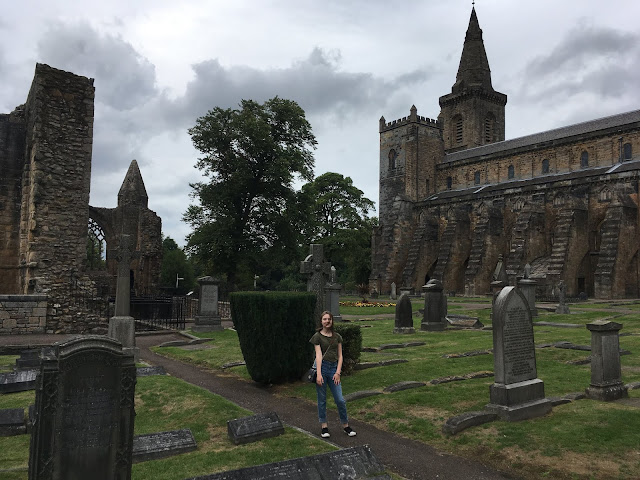August 2, 2018 - Scotland Trip Day 4 - Portknockie, Balmoral & Braemar Castles, Dunfermline, & Edinburgh
We said our last goodbye to Portknockie by checking out the local monument to sailors lost at sea. It is perched on a bluff, overlooking the bay that was once the location of a bustling industry known for its crafting of fine fishing boats.
The morning drive along the north coast, and then heading inland, was very beautiful! The map below shows our path for the day.
We loved the long horned, long haired cows - like teddy bears!
We had hoped to see Balmoral Castle (the Scottish holiday home to the Royal Family), but some of the British Royal Family were in residence, so it was not open to the public on that day. We could not even catch a glimpse of it, as it was deeply surrounded by forest. However, we did get to go see the nearby church, Crathie Kirk, that is attended by the local residents and the Royal Family when they are in residence at the castle.
Balmoral is out in those trees behind Mark.
We also stopped by the local cemetery.
Crathie Kirkyard is the final resting place of some famous Scots, including John Brown, the beloved personal attendant and friend of Queen Victoria.
The heather and fireweed along the drive south were very beautiful. The area felt wild and open.
We happened upon Braemar Castle and had to stop to enjoy the grounds a bit. It was built in 1628 (actually re-built from an older version), by the 18th Earl of Mar. It has been renovated and leased to the local community to be used for all sorts of community events, including annual Highland Games. It has an interesting star shaped wall all around the base, and once had a proper moat around it all. There are historical tours but we did not feel that we had the time to do that, so we pushed on to Dunfermline.

Can you see Mark in the picture below?
Can you find Neal in the picture below?

The drive from Braemar Castle to Dunfermline was interesting and beautiful!
Neal and Jackie really wanted to see Dunfermline because of the many ancestors that they have that came from this city. The large abbey in the city is a major cultural and historical point of interest. This is one of the main burial places in Scotland for those of fame or royal blood. We did not find any headstones of ancestors, but it is likely that there might be some there!
This abbey was built after the 1560 sacking of the medieval Benedictine abbey which was there before it, which was built in 1128! Portions of the earlier abbey are still standing and can be toured.
If you are interested in Scottish history and the reason behind the words built into the abbey's roof decor, here is an excerpt from an online article about "King Robert the Bruce":
He was Scotland’s greatest “Warrior King” and the discovery of his skeleton by workmen in a vault in the grounds of Dunfermline Abbey – the former capital of Scotland and the resting place of many kings and queens – created a sensation around the world.
Now 200 years on from that remarkable day when the remains of King Robert the Bruce were found covered in lead and wrapped in a golden shroud on 17 February 1818, the event is to be celebrated with a special event allowing people to visit his tomb behind the pulpit of Abbey Church this Saturday.
Our last stop for the day was Edinburgh! The rocky hill in the picture below, called the Salisbury Crags, overlooks the city of Edinburgh. We thought that the nice view out over the city was a great place to start our Edinburgh experience. Jackie was patient enough to read her book while the four of us went for a little hike.
Not surprisingly, Hannah wasn't exactly thrilled with our decision to hike to to the top of the crags.
We found our Airbnb apartment in Linlithgow, a town about 25 minutes west of Edinburgh (sorry, forgot to get pictures of it), got some dinner, and planned to see the city more closely the following day.




































































Comments
Post a Comment